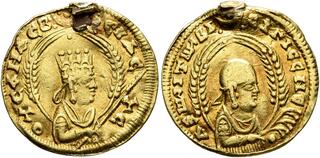| Leu Numismatik AG > Web Auction 28 | Auction date: 9 December 2023 |
| Lot number: 5356 Price realized: 650 CHF (Approx. 739 USD / 686 EUR) Note: Prices do not include buyer's fees. | Show similar lots on CoinArchives Find similar lots in upcoming auctions on |
| Lot description: Ousanas I, circa 325-345. Chrysos (Gold, 18 mm, 2.24 g, 12 h). ΟΥCΑΝAC Β-ACIΛЄ-ΥC Draped half-length bust of Ousanas I to right, wearing long garment, tiara and circular earring, holding spear in his right hand and with bracelets on his right arm; to left and right, ears of barley; above, pellet and pellet in crescent surrounded by four pellets. Rev. ΑξⲰΜΙΤⲰΝ BI-CI ΓΙCЄΝЄ Draped half-length bust of Ousanas I to right, wearing long garment, tight-fitting head cloth and circular earring, holding branch in his right hand and with bracelets on his right arm; to left and right, ears of barley; to lower right, pellet; above, pellet in crescent surrounded by four pellets. Hahn, Aksumite, 12a. Hahn & Keck, MAKS, 14. Munro-Hay, AC, type 24. Original suspension loop broken off and the flan slightly wavy, otherwise, very fine. From the Dr. Stephan Coffman Collection, ex Noonans, 8-9 March 2023, 85. It was probably under Ousanas I (who may also have been called Ella Amidas, not to be confused with the later Alla Amidas) that Christianity was first introduced in Axum by Frumentius, one of two Roman boys reportedly captured after a raid on a ship docked at an Axumite harbor (for the full story, see lot 296 below). Munro-Hay suggested that this sudden aggression resulted from the death of Licinius I in 324, which could temporarily have led any treaties between Rome and Axum to lapse. However, this is perhaps an overinterpretation, as occasional acts of piracy were commonplace in Antiquity, certainly in such distant and contested regions as the Red Sea. In any case, relations between the Axumites and the Empire remained close, and Ousanas lowered the weight of his chrysoi to accord with that of Constantine I's solidi (the chrysoi now circulating as half solidi, or semisses), no doubt to facilitate trade. Inscriptions imply that Ousanas enjoyed a long reign, and Hahn & Keck (MAKS, p. 70-71) have suggested that the pellets surrounding the crescents may indicate regnal years, with the large pellet on the bottom right of the reverse symbolizing a ten. Tempting as such an interpretation is, it does seem rather speculative, and we should perhaps accept that we do not know the meaning of the pellets. Despite (or because of?) its longevity, Ousanas' reign appears to have been troubled by political turbulence towards the end, as a usurper called Wazeba may have claimed the throne. Starting price: 200 CHF |  |



